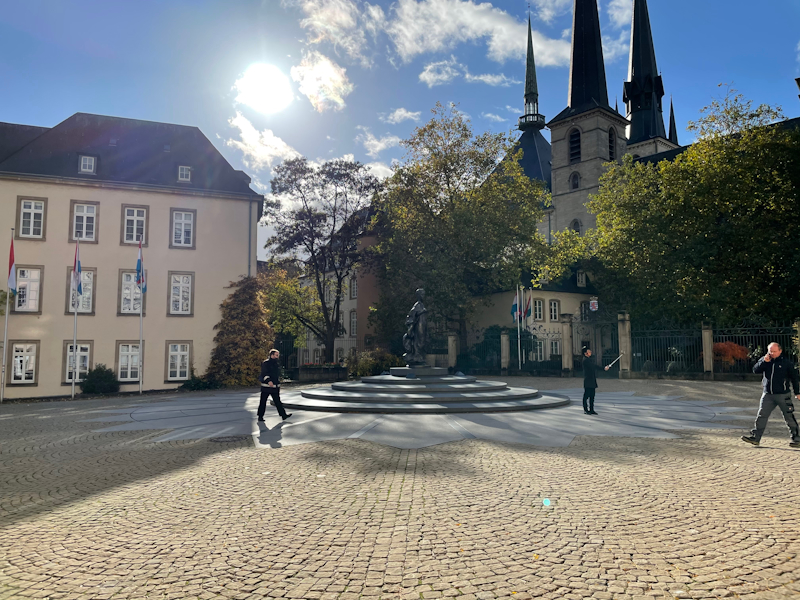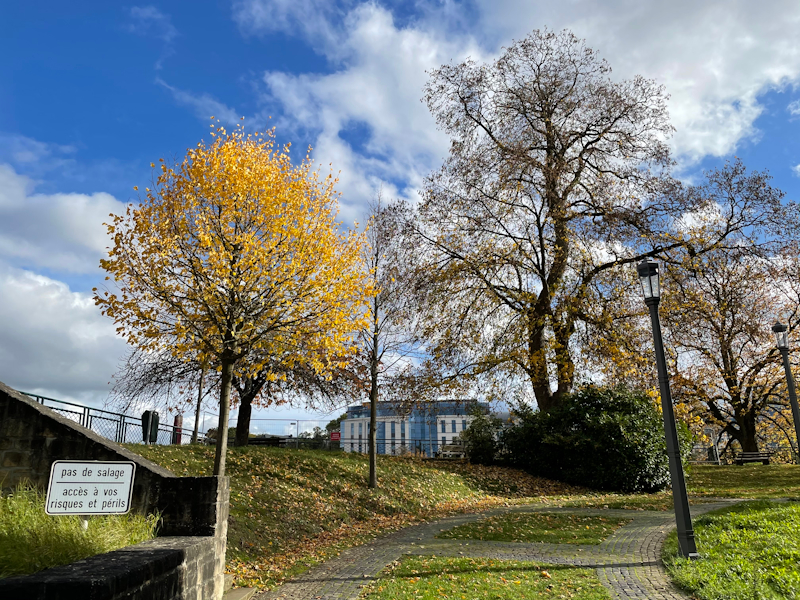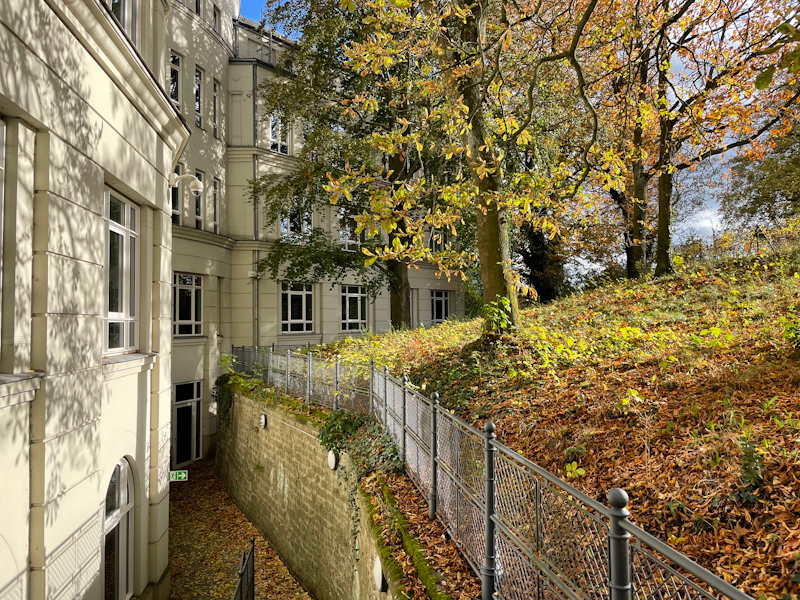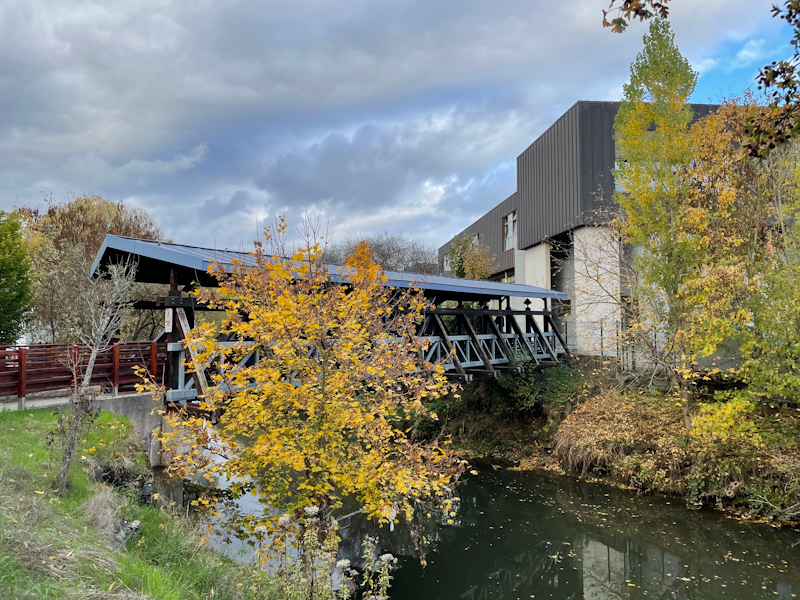The iPhone 12 & 12 Pro Review: New Design and Diminishing Returns
by Andrei Frumusanu on November 30, 2020 8:30 AM EST- Posted in
- Mobile
- Apple
- Smartphones
- Apple A14
- iPhone 12
- iPhone 12 Pro
Camera - Daylight Evaluation
The iPhone’s 12 and 12 Pro’s camera setup we’re reviewing today isn’t very exciting when looking at the paper specifications. Compared to the iPhone 11 Pro, the 12 Pro’s only real change is a new optics system on the part of the main camera, increasing the aperture from f/1.8 to f/1.6. The telephoto module and ultra-wide angle both remain seemingly the same at 12MP f/2.0 at 52mm equivalent, and 12MP f/2.4 at 13mm equivalent.
Where things might have changed more substantially is on the software processing side of things, where Apple has promised new improved HDR algorithms, enabled by the new processing power of the A14 SoC.
We’re limiting the comparison pictures here to the iPhone 12 Pro, with the iPhone 12 of course lacking the telephoto module but otherwise having identical hardware, the iPhone 11 Pro, as well as the latest Samsung flagship in the form of the Note20 Ultra, and S20+, as well as a Pixel 4 for the daylight pictures.
I’m including a Fujifilm X-T30 mirrorless ILC with an 18-55mm f/2.8-4 as a reference camera for the sake of colour accuracy comparisons. The shots here have been edited for dynamic range recovery and my best effort reproduction of the actual scenes.

[ iPhone 12 Pro ] [ iPhone 11 Pro ]
[ Note20 Ultra (S) ] [ S20+ (E) ]
[ Pixel 4 ] [ X-T30 ]
In this first scene I tried a worse-case scenario for the phones, shooting a contrasty scene against the sun, fully stressing the HDR algorithms of the cameras as well as the optics.
The new iPhone 12 Pro’s main camera doesn’t change the composition and exposure of the scene all too much compared to the iPhone 11 Pro, however we do see quite a bit better contrast. The sky’s discoloration around the sun is also less pronounced than on the iPhone 11 Pro, both signs that the new optics are of a high quality.
On the ultra-wide angle, we’re also seeing improved contrast – given that the hardware looks to be the same this would rather point out to an improved handling of HDR processing on the part of the new phone.

[ iPhone 12 Pro ] [ iPhone 11 Pro ]
[ Note20 Ultra (S) ] [ S20+ (E) ]
[ Pixel 4 ] [ X-T30 ]
The weather was quite cloudy during the shooting of these scenes but I tried my best to capture consistent shots between the phones. What’s immediately noticeable across all the shots of the new iPhone 12 Pro versus the 11 Pro is that while colours and general exposure is similar, the 12 produces higher contrast results which pop out more than on the predecessor.
On the telephoto module, oddly enough it feels as if things aren’t quite as detailed on the new phone as we’re seeing a HDR-like smudging of fine details such as the foliage and roof tiles of the scene. The main cameras are about the same, while on the ultra-wide angle I’d actually say the 12 Pro is able to preserve more details.

[ iPhone 12 Pro ] [ iPhone 11 Pro ]
[ Note20 Ultra (S) ] [ S20+ (E) ]
[ Pixel 4 ] [ X-T30 ]
In this next scene you’d be hard-pressed to differentiate the new iPhone. The only real difference on the part of the main camera I’m seeing are actually less defined shadows compared to the iPhone 11 Pro.
On the ultra-wide module, things change more dramatically, with much better detail retention on the new phone. Here we’re also seeing a large change in perspective correction between the two generations, especially in the corners of the image.
Compared to the competition, Apple doesn’t fare as well in terms of details as the Samsung phones are able to retain quite significantly more finer details throughout the scene while the iPhones seem to be smudging things out through the processing. Samsung’s HDR on the ultra-wide is also able to retain a better dynamic range, with more details in the shadows having been preserved.

[ iPhone 12 Pro ] [ iPhone 11 Pro ]
[ Note20 Ultra (S) ] [ S20+ (E) ]
[ Pixel 4 ] [ X-T30 ]
In this next scene it’s again visible that the new phone is able to showcase higher contrast levels. One thing that I don’t like very much on the Apple phones or the Pixel is the colour temperature which is quite too warm for this scene, being quite inaccurate compared to the real scene at the time and what the Fuji was able to capture. The Samsung phones aren’t quite as off and the best amongst the phones here.

[ iPhone 12 Pro ] [ iPhone 11 Pro ]
[ Note20 Ultra (S) ] [ S20+ (E) ]
[ Pixel 4 ] [ X-T30 ]
This is also a scene where the colour temperature of the new iPhone 12 seems to have gotten worse, being far too warm again compared to the actual scene as well as warmer than the 11, with the Samsung phones being far better in that regard.
HDR processing is much improved, especially noticeable on the ultra-wide of the new iPhone which retains a lot more details and handling of tones.

[ iPhone 12 Pro ] [ iPhone 11 Pro ]
[ Note20 Ultra (S) ] [ S20+ (E) ]
[ Pixel 4 ] [ X-T30 ]
Here again, the 12 produces a warmer picture than the 11, and veers off further away from the actual colour of the scene.
Apple opted to retain a traditional telephoto module setup on the new iPhone 12 Pro; what’s odd here is that again we’re seeing worse detail retention compared to the 11 Pro even though the hardware should in theory be the same.
This is especially visible when you have to user higher digital zooming, as the 5x magnification of the iPhone 12 Pro looks to me considerably worse than the 11 Pro. It’s as if there’s a heavy layer of noise reduction applied to the new phone’s camera processing on this new module.
Naturally, the 2x optical module can’t compete against some of the newer, more exotic camera solutions such as on the Note20 Ultra, but even the S20+’s 64MP unit using cropping and digital zooming vastly outperforms the telephoto module of the iPhone.

[ iPhone 12 Pro ] [ iPhone 11 Pro ]
[ Note20 Ultra (S) ] [ S20+ (E) ]
[ Pixel 4 ] [ X-T30 ]
This scene is a more noticeable improvement for the iPhone 12 Pro, with better HDR tone mapping as well as a better, more accurate colour temperature, although it’s still quite far off from reality, closest matched by the Note20 Ultra which has a near perfect reproduction.

[ iPhone 12 Pro ] [ iPhone 11 Pro ]
[ Note20 Ultra (S) ] [ S20+ (E) ]
[ Pixel 4 ] [ X-T30 ]
This last scene didn’t have a very high dynamic range as it was getting almost fully overcast; the new iPhone 12 behaved quite weirdly in terms of exposure of the foliage, as it lost saturation and is far too grey compared to the more accurate iPhone 11 shot. The Pixel 4 here had the best reproduction of the actual scene in terms of exposure and colours.
Daylight Conclusion: Better HDR, in Some Situations
Overall, the iPhone 12’s biggest changes in daylight captures can be summed around the fact that it has a new HDR algorithm, that in the majority of cases, produces better and higher contrast results. On the main camera, it’s a general positive although there’s a few scenes where for some reason the iPhone 12 processing fared off worse in terms of colour temperature and colour accuracy. Although the iPhone 12 performed well here overall, the main camera didn’t handle things as detailed or as accurately as the Note20 Ultra.
The ultra-wide angle seems to be universally improved this generation and that’s a much welcome change for the new devices: it showcases much better detail retention as well as better HDR processing. It’s still not quite at the same level as Samsung’s unit here but it’s much closer than before.
What’s quite disappointing on the new iPhone 12 Pro is the telephoto module. I felt that it universally was worse off than the 11 Pro due to the fact that it just couldn’t match the detail retention of its predecessor. I think this may be due to the new HDR processing that merges subsequent captures together. In any case, it doesn’t hold a candle to the competitions telephoto solutions which are significantly superior in hardware capabilities.










101 Comments
View All Comments
GC2:CS - Monday, November 30, 2020 - link
Displaymate says peak white is like 10% down compared to 11 Pro.11 Pro was 8% down from the XS but at higher max brightness the efficiency suffers (apple said 15% better isoperf).
That combined with the A14 would pretty much eliminate any fears of downgraded battery life. Unless you turn 5G on.
KPOM - Monday, November 30, 2020 - link
Still better than what iPhones can draw from normal Qi chargers.calleng - Monday, November 30, 2020 - link
All this talk about edges and surface of the phone is bull. Who uses an iphone without a proper case. Maybe apple should make them out of rubber.Andrei Frumusanu - Monday, November 30, 2020 - link
If we didn't care about the design then why bother with a heavier steel variant then? I don't care for cases for one and use all my phones naked.zanon - Monday, November 30, 2020 - link
calleng is completely off base but I do sympathize with Apple being tugged multiple ways here. If 70-80% of owners use a case, well, 20-30% naked is still a LOT. Tens of millions, and reviewers in particular always mention it, and it's what people feel in the store too. So it definitely matters to pay major attention to a quality naked phone experience. Yet that doesn't change a super majority using it with a case, and Apple can't possibly be completely ignoring that either."Why bother with a heavier steel variant then" though really is an interesting question give the noticeable weight difference. There are lots of other premium materials, titanium of course but also all sorts of alloys and even ceramics that Apple has worked with in the past. Steel is certainly really versatile and can be very tough, but it's still a curious choice for a company that has tended to pay a lot of attention to weight and hand feel. As you say in the review it's genuinely debatable if it even is more "premium" here, and it's not like Apple doesn't have serious materials chops. They have high end titanium case options for their watches as well.
cha0z_ - Tuesday, December 1, 2020 - link
The last pools I saw on the subject (this summer), it was 50% using their phones naked and 50% with a case. ;) the pool had around 40 000 voters.cha0z_ - Tuesday, December 1, 2020 - link
Same, used all of my phones totally naked (no case, no screen protector) - all in perfect condition.FunBunny2 - Tuesday, December 1, 2020 - link
from what I gather, most cracked screens are from butt compression due to carrying in back pocket. spongy rubber-ish case won't stop that.iphonebestgamephone - Tuesday, December 1, 2020 - link
Look harder and youll see how its not perfect.Unashamed_unoriginal_username_x86 - Tuesday, December 1, 2020 - link
I know it's not as comfortable or sexy, but I hope you put something on when you go outside. I don't want you getting arrested!